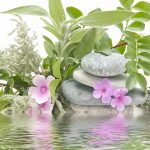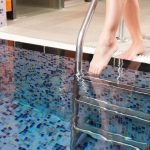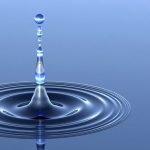Sussanna Czeranko, ND, BBE
Nature Cure Clinical Pearls
All persons who previously had made use of mercury, when using the water cure, became again subject to salivation and ulcers, a sure sign that the cure takes effect, and that invigorated nature rids herself of the poison urged upon her. Francis Græter, 1842, p.160
Mercury is then only lurking like a snake; and as soon as disease overcomes the body, it will assuredly creep out of its ambush, in order to exert its malignant influence in the work of destruction. Charles Schieferdecker, 1844, p.47
Water cures the organism of no disease, but it forces the organism to cure itself.
Charles Schieferdecker, 1844, p.56The medical commission analyzed the Græfenberg water to discover its mystic virtues but how they were disappointed to find it was nothing but pure spring water! Joel Shew, 1851, p.21
Vincent Priessnitz
Vincent Priessnitz brought something very extraordinary to the medical enigma of curing disease. I have been fascinated with Priessnitz’s immense yet marginally recognized contributions to medicine, and with his understanding of diseases. I am in good company in my admiration for this man who anchored his personal and professional life in his prescient and powerful beliefs and convictions. The doctors who flocked to study with Priessnitz observed his safe and effective treatments in a countless number of patients suffering from mercury toxicity. In witnessing what Priessnitz was able to accomplish with severely ill patients without prescribing a single drug, these doctors recognized the sham, shame, and travesty that allopathic medicine inflicted onto an innocent public. These writers had all studied with Priessnitz and were followers with a special fervor to teach others of his brilliance. Taking his lead, they did not hesitate to point out the dangers of treatments that involved mercury. One such student, Dr Schieferdecker, was in disbelief that other doctors could not recognize the miraculous work of Priessnitz’s water therapies. With a plea of reason, Schieferdecker writes,
The mission of a doctor is to alleviate pains, calm irritation, [and] extinguish the burning heat which accompany inflammation and fever; to moisten, dilute and attenuate all that is dry, thick and hardened; to soften down acrimony; to reduce obstructions; to dissipate congestions; to keep all the excretive passages open to make all movement converge thither, to attract there all hurtful humours, to operate their discharge, [and] lastly, to keep up the strength of the invalid, accordingly, to the wants of nature, which must itself labour in this great work, the accomplishment of which the doctor should aid, and never impede. (Schieferdecker, 1844, p.iv)
Allopathic Medicine
Allopathic medicine at that time had offered very little hope for the sick, especially when their tools included poisonous drugs such as mercury and the then-golden standard, bloodletting. Their methods of silencing symptoms suggested that they understood how to alleviate disease. However, those who followed Priessnitz exposed and unraveled the error in such practices.
Priessnitz viewed the presence of fever and inflammation as a sign of the body attempting to eliminate deleterious matter from the body. The fever and the heat produced brought to the skin surface the deleterious compounds, and all would be eliminated if the body was left to its wisdom. These symptoms of fever or inflammation were “the true signs of nature operating wholesomely.” (Schieferdecker, 1844, p.28)
The allopathic community, however, classified the fever as a disease that required intervention. Those initiated in the use of water knew better and saw the fever as “a tendency to health.” The use of drugs or bloodletting, they contended, masked the signs of disease, and whatever was the cause of disruption would then be harbored within the body. Schieferdecker summarizes: “The great error of [the Allopathic] school may be traced to their false notions of the nature and cause of diseases; and in supposing fever and inflammation to be diseases, instead of what they really are―symptoms or means essentially necessary in every real cure.” (Schieferdecker, 1844, p.29) Priessnitz, instead of killing the fever, used the fever to evacuate the injurious elements from the body.
The use of drugs such as mercury, and the procedure of bloodletting to treat fever and inflammation, resulted in asymptomatic patients but also depleted these patients, compromising their capacity to rally against the precipitating causes of their disease. These strong drugs extinguished the body’s innate forces to mount a fever in its effort to rid the body of the matter that was responsible for causing the fever in the first place. The allopathic cure consisted of substituting the fever and inflammation with a state of debility and opening up the door to chronic diseases.
Mercury Poisoning
The books written by doctors who worked and studied with Priessnitz in the mid-19th century, while the great Father of Hydrotherapy was still living, point out that those who had exhausted the efforts of conventional medicine showed up at Graefenberg, “a small colony of some twenty houses and situated half way up a mountain.” (Shew, 1851, p.11) Just as today, naturopathic doctors are often the last resort by many of our patients who have tried everything under the sun. The patients who consulted Priessnitz were desperate for health, and the journey was arduous and difficult. For the majority of them that could afford the long travel, they did not come in vain. The prevalent use of mercury in the 19th century would mean that most of those patients seen by Priessnitz were mercury toxicity cases. Schieferdecker insinuates that anyone who had been treated by an Allopath would have been exposed to mercury. Græter reports the same: “In Græfenberg, abuse of mercury diseases are of frequent occurrence, mostly connected with syphilis.” (Græter, 1842, p.159) Schieferdecker included scrofulous skin diseases, digestive and women’s diseases, gout, and rheumatism to the list of mercury abuse cases.
Priessnitz treated thousands of patients in his lifetime, and most, if not all, of these patients had begun their relentless search for answers to their health problems by going to an Allopath. Schieferdecker notes, “Priessnitz has found, from the experience of many individuals that mercury can lie for many years inactive in the organism, apparently in a state of sleep. But it is then only lurking like a snake; and as soon as disease overcomes the body; it will assuredly creep out of its ambush, in order to exert its malignant influence in the work of destruction.” (Schieferdecker, 1844, p.47)
Such a description of mercury poisoning as a snake waiting to ambush at the first opportunity of weakness gives us insight into the plight of those with mercury toxicity. Patients undergoing mercury treatment would be given large, gross quantities. Today, our exposure to mercury is insignificant in comparison. Mercury poisoning was not a mild disease, as we know very well today. “In no disease is the crisis more violent and painful by ulcers than in mercurial complaints, therefore in no case is the special attention of a skillful water-physician more required than in such instances.” (Schieferdecker, 1844, p.47)
Reading the accounts of cases that were treated in Græfenberg, one gets a clear picture that the patients traveled from far and wide. They came because their diseases were hopeless. “Amongst the chronic diseases curable by water, mercurial languor, in its infinitely variegated forms, stands at their head. It is admitted that half of the patients at Græfenberg came to reject this metal.” (Schieferdecker, 1844, p.59) Priessnitz gave them cause for immense hope, but his treatments were not a matter of simply taking a pill; water therapy required a complete embrace of new habits.
One example of a case was described by Dr Joel Shew: “A delicate female came to Græfenberg to be cured of a liver complaint. The disease arose from inflammation in the liver, to cure, which, by the allopathic system, she had been treated with mercury.” (Shew, 1951, p.25) She underwent the cold water treatments under the care of Priessnitz. “In a short time, she had a crisis of boils, through which the mercury evaporated. Immediately after these had healed, the inflammation of the liver returned.” (Shew, 1851, p.25) The return of this symptom was a sign that the original acute symptom was present, and with Priessnitz’s water therapies the patient fully recovered. When the hydrotherapy elicited the return of the original acute disease, the cure was assured. “The healing of all acute diseases to Priessnitz is but play.” (Schieferdecker, 1844, p.59)
What constituted a successful cure of mercury poisoning for Priessnitz? This answer comes from Schieferdecker: “The Hydriatric is that mode of curing, which, by the application of the coldest water alone, (without the help of ice or any artificial means), entirely ejects all the material causes of disorders, under whatever form they may appear, from every part of the human organism.” (Schieferdecker, 1844, p.51)
Very, Very Cold is the Half Bath
Schieferdecker provides wisdom and guidance of the approach as follows:
In acute diseases, the tendency of the cure is directly to remove the causes of the disease, either by purging and vomiting (in gastric complaints), or commonly by bathing and sweating. In chronic diseases, on the contrary, the aim is to turn them into acute attacks―for these are the crises of the water cure by which the healing is easily and successfully obtained. (Schieferdecker, 1844, p.66)
Before a treatment for a chronic disease began, the patient was habituated to cold water by having a lukewarm half bath and ablutions. By no means, however, was the bath lukewarm when compared to contemporary temperature tolerances.
The half bath was considered “one of the mildest of water-cure processes, or as one of the most powerful.” (Shew, 1851, p.69) Priessnitz designed his half-bath tubs to measure “four to five feet long, about two and a half feet wide and twenty inches deep.” (Shew, 1851, p.69) The patient sat in water about 3 to 6 inches deep, and the temperature of lukewarm water was 60° to 70° F/16° to 21° C. These water applications were given first to help the patient adjust to the temperature of a cold, full bath. The half-bath was also used after a sweating blanket procedure [see last month’s article], and a pail of cold water was poured over the patient. (Græter, 1842, p.89)
Priessnitz used the half bath to induce sweating. “Daily half baths of an hour’s duration were continued until the fever produced has deposited the morbid matter in critical ulcers, discharging whole tumblers of purulent matter.” (Græter, 1842, p.89)
Shew cites 4 indications for the Half Bath (Shew, 1851, p.70):
- To cool the blood circulation during fevers and inflammation
- To be used as a revulsive or means of deriving blood in congestions of the “noble” organs, brain, lungs, stomach, liver, etc
- To resuscitate in cases of shock, in serious accidents, sun stroke, before and during fits of anger, in drunkenness, and delirium tremens
- To prepare weak patients for colder water temperatures
Priessnitz employed friction during the half-bath for the treatment of fever and inflammation that would last from 6 to 9 hours in length. A team of bath attendants were required to perform the friction rubs without any interruptions.
Four O’clock in the Blanket Wrap
The days at Græfenberg always began early in the morning at 4 AM with a blanket wrap to induce perspiration (Figure 1). Before the patient was snuggly wrapped up in the woolen blanket, drinking cold water was strongly advised, since the next opportunity to drink wasn’t allowed until perspiration occurred. A clue that sweating was imminent were signs of restlessness. At this juncture the patient was instructed, while still bound up within the blankets, to rub legs together and move arms against the body. When perspiration broke, the patient was then permitted to drink cold water every 15 minutes. The perspiration phase lasted no longer than 2 hours, and when the patient had perspired adequately, it was now time for the cold bath. One precaution was to ensure that the sweat-drenched patient remained well-wrapped and covered for the short walk to the waiting cold water bath.
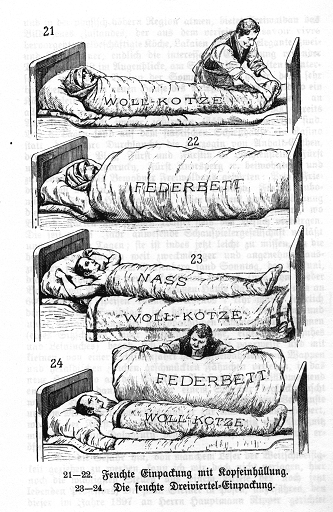
The Cold Bath
The bath tubs where patients took the cold bath were extremely large: 20 to 30 feet in circumference (Figure 2). (Græter, 1842, p.86) “The temperature of the water at Græfenberg was 43° to 50° F /6° to 10° C and in general nobody remained longer than six or eight minutes in the tub; most people, only from one to three minutes.” (Græter, 1842, p.88) Schieferdecker cites that 1 to 5 minutes in the cold water was sufficient. Patients were advised to move while in the huge bathtub. After the bath, the patient dressed and took a walk for half an hour before eating breakfast. (Schieferdecker, 1844, p.70)
On entering these frigid temperatures, it is natural to feel an immediate chill; however, this chill passes and staying in the water is possible. The subsequent chill is the one to pay much attention to, indicating that the patient should leave the cold water bath immediately. Græter provides an explanation from his teacher: “Priessnitz advises carefully not to avoid the first chill in entering, but the second, the feverish one, and to leave the bath before it comes, in particular in the period of crises by fevers and ulcers, when an excessive reaction might confine the patient to his bed, and retard the cure.” (Græter, 1842, p.88)
Placing a perspiring patient into frigid temperatures of an icy, cold bath could, Schieferdecker warns, result in imprudent behaviors as part of the cold bath treatment. Schieferdecker offers the following:
Several thousands of experiments, many of them furnished by very weak patients, have placed it beyond all doubt that the cold bath is most salubrious when taken whilst the skin was steaming; only provided, that the perspiration was not produced by motion exciting the whole organism, but in a state of rest under warm coverings. (Schieferdecker, 1844, p.72)
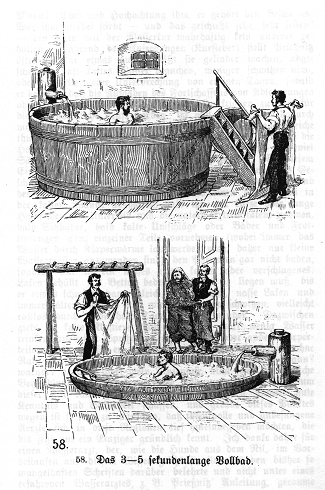
Falling or Douche Bath
These blanket sweating wraps with the cold baths are continued for 8 to 14 days, at which time another water application is added to the daily protocol. The falling, or douche, bath is a stream of water that falls from several feet. Shew describes these douches that were found scattered throughout the forests at Græfenberg: “A stream of water, an inch or two in diameter, with a fall of ten, fifteen or twenty feet, may be said to constitute an ordinary douche.” (Shew, 1851, p.66) Schieferdecker goes on to describe one such douche, the “Sophia.” He explains, “The Sophia, this is the name of the most powerful of them is twenty feet high, and her ray of water is four inches in diameter.” (Schieferdecker, 1844, p.74) Rustic huts were built to allow privacy and “some [were] exclusively for women and others for men.” (Shew, 1851, p.67)
The water in the fall bath is very cold. The duration of the bath is 5 to 20 minutes and taken before lunch. Great caution was exercised to avoid water falling on the head. “Those who have weak lungs, stomach, or abdominal organs, should not take the douche upon those parts.” (Shew, 1851, p.67) The douche was an invaluable remedy for gout, rheumatism, and paralysis. “In some cases of swollen and painful joints, the relief obtained, in a very short time, by the douche, is little less than miraculous.” (Shew, 1851, p.68)
Two or 3 hours after the fall bath, another blanket sweating was taken, or a sitz or foot bath was indicated.
Sitting or Sitz Bath
Tubs that allowed for free movement of the arms and hands to be able to rub the abdomen were the ideal vessels for the sitz bath (Figure 3). “The more movement and friction, while in this bath, the better.” (Shew, 1851, p.72) Patients covered their upper body with a blanket or wore clothing.
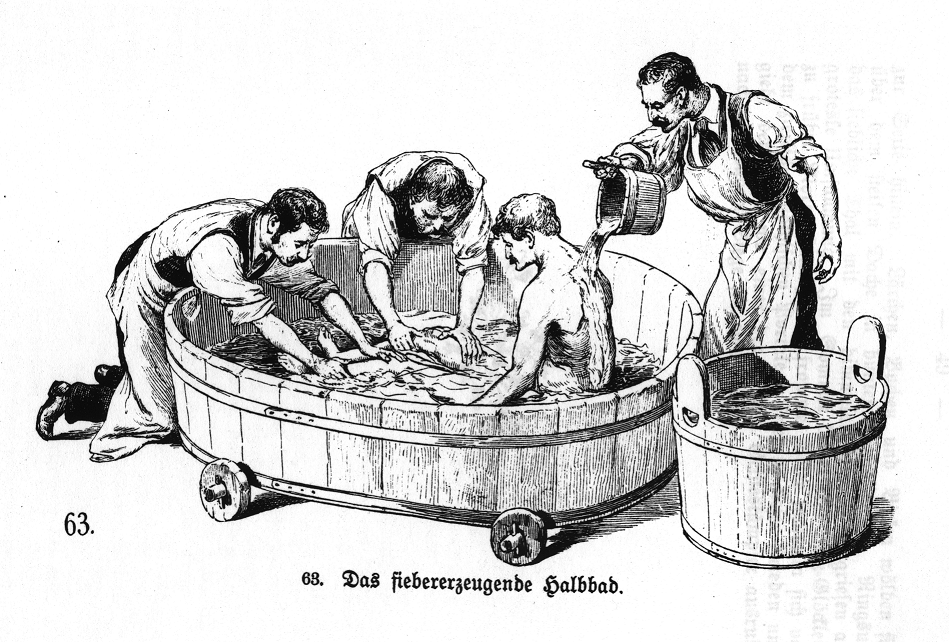
Shew adds, “As a tonic to the stomach, liver, bowels, womb, spine, etc., this bath is highly useful. In constipation and other irregularities, it is famous.” (Shew, 1851, p.72) The sitz bath was not administered if the patient was still digesting food from a meal. The sitz bath, in combination with ablutions, was used in pregnancy and leucorrhea. (Shew, 1851, p.73) “In all violent bleedings from the bowels, very cold Sitz baths should be used.” (Shew, 1851, p.74)
There were 2 types of sitting, or sitz bath, depending on its purpose. The first type of sitting bath was to improve digestion by removing the congestion from the chest and head. This bath lasted 10 minutes. The second type of sitting bath was to remove morbid matter from the rest of the body; then the bath lasted 20 minutes and as long as 40 minutes. To enhance the sitting bath, the patient would knead or rub their belly. (Schieferdecker, 1844, p.84)
Foot Bath
The day is not complete without a foot bath or another bath before retiring to bed. The foot bath had similar effects as the full bath. These cold baths moved “blood, heat, and the materials of diseases from the upper parts to the feet.” (Schieferdecker, 1844, p.85) One caveat for the foot bath is that the feet must be warm before doing this bath. If the feet were cold, then they were warmed with exercise or with rubbing and friction. The amount of water used in the foot bath was just enough to cover the feet, or 1 to 3 inches of water. (Græter, 1842, p.92) “Exercise, or at least friction, should be practiced after, as well as before the bath.” (Shew, 1851, p.77)
Foot baths were indicated for a variety of conditions: “for toothache, rushing of blood to the head, ear and headaches, inflamed eyes … also for controlling [nose] bleeding, the womb and difficulty in passing urine.” (Shew, 1851, p.77) The foot baths “were used almost exclusively for [relieving] pains in higher parts.” (Græter, 1842, p.92) Also in this list were foot corns, sprains, gout, and rheumatism.
If the purpose of the cold foot bath was to warm the feet, 10 minutes were needed. If the aim was to stir and expel deleterious matter, the baths could last for 40 minutes. “Such foot baths are to be recommended principally to those poisoned by mercury, since this poison is mostly deposited in the external parts of the body, ready to produce in its time podagra, paralytic symptoms, or to lay the foundation for dropsy [edema].” (Schieferdecker, 1844, p.86)
The whole day, then, was structured such that some kind of curative activity was continuously occurring for the patient. There was little if any time for socializing or bemoaning one’s condition. Life at Græfenberg was intensely preoccupied with healing.
As stated earlier, Priessnitz had his fair share of patients who sought him out after the treatments received from their medical doctors had failed. Doctors in the 18th century relied heavily on mercury as the first-line treatment for gout, liver complaints, constipation, diarrhea, and all kinds of skin complaints; the list goes on. Priessnitz treated and cured thousands of people suffering from the effects of mercury. Schieferdecker notes: “The experience at the Graefenberg has incontrovertibly established the fact, that a mercurial poisoning can only be cured by water.” (Schieferdecker, 1844, p.45)
The essence of the water cure at Græfenberg was the coldness of the water used. Entering a cold bath ensured that blood flow would be vigorous. Blood from the surface of the skin would be driven to the interior. Schieferdecker points out, “Two different signs prognosticate the desired cure: a very reddened skin after the bath, and the awakening of old pains. Cicatrices of old badly cured wounds frequently reopen.” (Schieferdecker, 1844, p.87) The healing process in the chronically sick patient meant that the body was aroused into action. The action or reactions indicated that the patient had the required strength to mount a healing crisis. Enough of the morbid matter was evacuated through the sweating and cold bathing that now the body was capable of having an acute reaction and finishing the cleansing of the body. Eruptions, ulcers, and discharges were common in the final stages of healing.
Closing Comments
Priessnitz was successful in detoxifying his severely sick patients of mercury at a time when mercury was broadly prescribed by medical doctors. We can learn still from him and re-discover his miraculous treatment protocols. In the next issue, we will be exploring further what Priessnitz had championed in Hydriatics.
References:
Græter, F. (1842). Hydriatics: Or, Manual of the Water Cure. New York, NY: William Radde Publisher, pp. 198.
Schieferdecker, C. C. (1844). Vincenz Priessnitz: the wonderful power of water in healing the diseases of the human body. Philadelphia, PA: Published by author, pp. 140.
Shew, J. (1851). The Water Cure Manual. New York, NY: Fowlers and Wells, pp. 280.
Image Copyright: <a href=’https://www.123rf.com/profile_aetb’>aetb / 123RF Stock Photo</a>
 Sussanna Czeranko ND, BBE, incorporates “nature-cure” approaches to primary care by including balneotherapy, breathing therapy, and nutrition into her naturopathic practice. Dr Czeranko is a faculty member working as the Rare Books curator at NCNM and is currently compiling a 12-volume series based upon Benedict Lust’s journals, published early in the last century. Her published books include: Origins of Naturopathic Medicine; Philosophy of Naturopathic Medicine; Dietetics of Naturopathic Medicine; Principles of Naturopathic Medicine; Vaccination and Naturopathic Medicine; and Physical Culture in Naturopathic Medicine. Dr Czeranko is the founder of the Breathing Academy, a training institute for naturopaths to incorporate a scientific model of breathing therapy called Buteyko into their practice. She is also a founding board member of the International Congress of Naturopathic Medicine and a member of the International Society of Medical Hydrology.
Sussanna Czeranko ND, BBE, incorporates “nature-cure” approaches to primary care by including balneotherapy, breathing therapy, and nutrition into her naturopathic practice. Dr Czeranko is a faculty member working as the Rare Books curator at NCNM and is currently compiling a 12-volume series based upon Benedict Lust’s journals, published early in the last century. Her published books include: Origins of Naturopathic Medicine; Philosophy of Naturopathic Medicine; Dietetics of Naturopathic Medicine; Principles of Naturopathic Medicine; Vaccination and Naturopathic Medicine; and Physical Culture in Naturopathic Medicine. Dr Czeranko is the founder of the Breathing Academy, a training institute for naturopaths to incorporate a scientific model of breathing therapy called Buteyko into their practice. She is also a founding board member of the International Congress of Naturopathic Medicine and a member of the International Society of Medical Hydrology.



